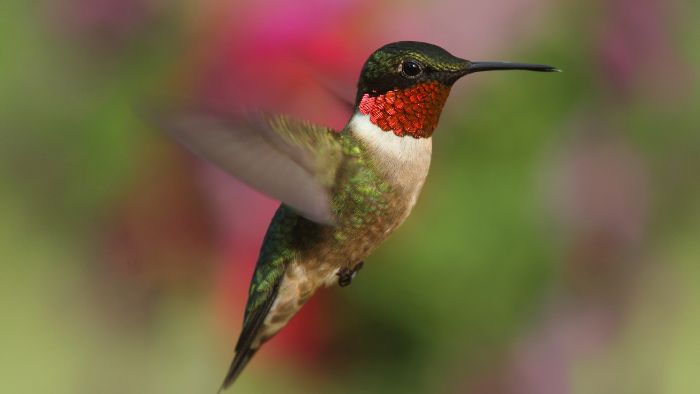What are the differences between male and female ruby-throated hummingbirds? Keep reading this short guide and become an expert in this field.
With more than 350 known species of hummingbirds roaming the skies, most people at first think it is very complicated to determine the sex of the vicious birds you see playing in their backyard. However, in reality, it is much different, that is, simpler. With a little guidance, you can become a champion in this interesting hobby.
Stay with us and learn what are the differences between male and female ruby-throated hummingbirds.
Top 4 Most Interesting Ruby-Throated Hummingbird Facts
Before we get to the heart of this article and say something about the differences between male and female ruby-throated hummingbirds, let us introduce you to this intriguing bird species.
- This amazing species of bird has the ability to see into the ultraviolet light spectrum or those colors that the human eye cannot even imagine.
- This species of hummingbird simply loves to enjoy the nectar of orange and red flowers compared to all other colors.
- Its nests can be found exclusively in the eastern United States, and the female usually lays between 1 and 3 eggs at a time.
- Their average lifespan is between 3 and 5 years, and the oldest (known) specimen of this hummingbird was as old as 9 years.
Now that you’ve met them, we’ll tell you a bit about the differences between male and female ruby-throated hummingbirds.

Differences Between Male And Female Ruby-throated Hummingbirds
As the name suggests, these beautiful hummingbirds owe their name to their unique colored throats. As for the differences between male and female ruby-throated hummingbirds, they are mostly related to their appearance, size, and behavior. Therefore, we will deal specifically with these three categories.
Appearance
Have you noticed that in the animal kingdom, males are often more extravagant in appearance compared to females? This trend is much more pronounced in hummingbirds than in elephants, for example.
Accordingly, males have more colorful feathers, more specifically, males generally have bright feathers while females look duller in color. Furthermore, males have a distinct look around their throats, i.e. their throats are more shimmery and iridescent compared to the throats of females which are quite pale.
One of the biggest differences between male and female ruby-throated hummingbirds is that the males have a distinctive ruby-colored throat while the females have simple, white throats. Furthermore, depending on the lighting as well as the angle from which this beauty is viewed, the throat can appear red, pink, and even purple.
Size
Another of the biggest differences between male and female ruby-throated hummingbirds is their size. Truth be told, it can be quite inconvenient, unless you have a knack for determining dimensions without a measuring tool, however, it can certainly be possible.
In terms of size, these birds usually weigh 0.11 ounces, are about 3 inches long, with a wingspan of 4 inches, but may appear even longer than the tail when the bird is resting. The most important thing to note is that males are about 20% smaller than females. Although they are juveniles, it is very difficult to distinguish them because they all look exactly the same, but over time, as they get older, the differences become more noticeable. In addition, males of this species have points at the end of their feathers.
Behavior
Male vs. female hummingbirds in terms of behavior is also one of the major differences between male and female ruby-throated hummingbirds. Male hummingbirds are more aggressive compared to females, and the most common reasons are territoriality and partner attraction. In addition, males produce scratching chirps to attract females or to quarrel with other males.
Furthermore, did you know that male hummingbirds migrate first before females? They practice this to establish their territory before the females arrive. Finally, we must emphasize that males are much more proactive, agile, and louder than females?
After mating, the female is left alone and raises the young on her own. Moreover, she chases away any males who venture near her nest because she is afraid that their bright colors will attract all kinds of predators.
To Wrap Things Up: Are There Any Differences Between Male And Female Ruby-Throated Hummingbirds?
Truth be told, distinguishing these two sexes can be quite difficult because hummingbirds can move up to 40 miles per hour. But don’t be afraid because it’s really doable if you dedicate yourself to observation.
As for the differences between male and female ruby-throated hummingbirds, they are mostly related to the appearance, size, and behavior of these unique, small birds. Males have a forked tail while, on the other hand, females have a fan-shaped one. As with most hummingbird species, males of this amazing species generally have bright feathers while the females look duller in color.

That would be it. Now you know all about the differences between male and female ruby-throated hummingbirds. If you have any questions, please feel free to contact us in the section below. We are looking forward to your reply.
Read more: Can Hummingbirds Fly In The Rain? The 2 Most Fascinating Attributes That Birds Rarely Have
FAQ’s
[rank_math_rich_snippet id=”s-2fe81fd2-3d4e-40d2-825e-2c6e70b299ce”]

